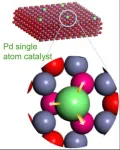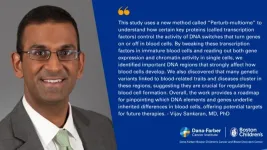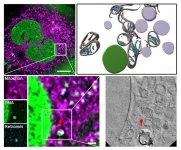(Press-News.org) University of New Mexico researchers studying the health risks posed by gadolinium, a toxic rare earth metal used in MRI scans, have found that oxalic acid, a molecule found in many foods, can generate nanoparticles of the metal in human tissues.
In a new paper published in the journal Magnetic Resonance Imaging, a team led by Brent Wagner, MD, professor in the Department of Internal Medicine in the UNM School of Medicine, sought to explain the formation of the nanoparticles, which have been associated with serious health problems in the kidneys and other organs.
“The worst disease caused by MRI contrast agents is nephrogenic systemic fibrosis,” he said. “People have succumbed after just a single dose.” The condition can cause a thickening and hardening of the skin, heart and lungs and cause painful contracture of the joints.
Gadolinium-based contrast agents are injected prior to MRI scans to help create sharper images, Wagner said. The metal is usually tightly bound to other molecules and is excreted from the body, and most people experience no adverse effects. However, previous research has shown that even in those with no symptoms, gadolinium particles have been found in the kidney and the brain and can be detected in the blood and urine years after exposure.
Scientists are left with intertwined puzzles: Why do some people get sick, when most don’t, and how do gadolinium particles become pried loose from the other molecules in the contrast agent?
“Almost half of the patients had been exposed only a single time, which means that there’s something that is amplifying the disease signal,” Wagner said. “This nanoparticle formation might explain a few things. It might explain why there's such an amplification of the disease. When a cell is trying to deal with this alien metallic nanoparticle within it, it's going to send out signals that tell the body to respond to it.”
In their study, Wagner’s team focused on oxalic acid, which is found in many plant-based foods, including spinach, rhubarb, most nuts and berries and chocolate, because it binds with metal ions. The process helps lead to the formation of kidney stones, which result when oxalate binds with calcium. Meanwhile, oxalic acid also forms in the body when people eat foods or supplements containing vitamin C.
In test tube experiments the researchers found that oxalic acid caused minute amounts of gadolinium to precipitate out of the contrast agent and form nanoparticles, which then infiltrated the cells of various organs.
“Some people might form these things, while other do not, and it may be their metabolic milieu,” Wagner said. “It might be if they were in a high oxalic state or a state where molecules are more prone to linking to the gadolinium, leading to the formation of the nanoparticles. That might be why some individuals have such awful symptoms and this massive disease response, whereas other people are fine.”
The finding points to a possible way to mitigate some of the risks associated with MRI scan, he said.
“I wouldn't take vitamin C if I needed to have an MRI with contrast because of the reactivity of the metal,” Wagner said. “I'm hoping that we're getting closer to some recommendations for helping these individuals.”
The team is now researching ways to identify those who might be at greatest risk from gadolinium contrast agents. In a new study they’re building an international patient registry that will include a collection of blood, urine, fingernail and hair samples, which could provide evidence of gadolinium accumulation in the body.
“We want to get a lot more information to come up with the risk factors that relate to those with symptoms,” he said. “We’re going to ask about what medical conditions you had at the time of exposure, what medications are you on, and we want to include dietary supplements, because that might piece it all together – why some people have symptoms, whereas others seem to be impervious.”
END
UNM scientists discover how nanoparticles of toxic metal used in MRI scans infiltrate human tissue
2025-04-04
ELSE PRESS RELEASES FROM THIS DATE:
UMaine research examines best methods for growing Atlantic sea scallops
2025-04-04
A new study from the University of Maine’s Aquaculture Research Institute (ARI) and Darling Marine Center is helping to refine best practices for growing Atlantic sea scallops (Placopecten magellanicus), a species of increasing interest to Maine’s aquaculture sector.
Published in the academic journal Aquaculture, the research compares two scallop farming methods, ear-hanging and lantern net culture, over a complete grow-out cycle to determine which approach yields the best results for commercial growers. The study, led by UMaine ...
Medical cannabis could speed recovery, especially at community recovery homes
2025-04-04
A new pilot study from UBC Okanagan and Thompson Rivers University examined how medically supervised cannabis use in a residential recovery home may support people in treatment for substance use challenges.
Participants reported that cannabis helped them manage pain, anxiety, depression and sleep issues—key symptoms that can complicate recovery.
"Our findings suggest medical cannabis could play a meaningful role in reducing cravings and improving retention in recovery programs," says ...
Study assesses U.S. image amid weakening of democracy
2025-04-04
The erosion of democracy in the U.S. has been a topic of concern in recent years, especially after protesters stormed the U.S. Capitol on Jan. 6, 2021, in an attempt to block the certification of Joe Biden's election as president. Most of the academic studies on democratic backsliding, however, have focused on public opinion within the U.S. and have not looked at global public opinion.
How favorably others view the U.S. is part of the country's "soft power"—a term coined by Joseph Nye at Harvard University in the 1980s. It refers to a country's ability to influence other countries’ policy ...
Two scientific researchers to receive 2025 Ralph L. Sacco Scholarships for Brain Health
2025-04-04
DALLAS and MINNEAPOLIS, April 4, 2025 — The American Academy of Neurology and the American Heart Association have awarded the 2025 Ralph L. Sacco Scholarships for Brain Health to two researchers, Hortense Triniac, Ph.D., of Milwaukee and Katy Walsh, Ph.D., of Boston. Each will receive a $150,000 two-year scholarship to support continuing scientific research in brain health. This is the second year this scholarship has been awarded.
The Ralph L. Sacco Scholarships in Brain Health, also known as the Sacco Scholars program, are made possible by a generous bequest to the American Academy of Neurology, the world’s largest association of neurologists ...
Researchers improve chemical reaction that underpins products from foods to fuels
2025-04-04
CORVALLIS, Ore. – A chemical reaction that’s vital to a range of commercial and industrial goods may soon be initiated more effectively and less expensively thanks to a collaboration that included Oregon State University College of Engineering researchers.
The study, published in Nature, involves hydrogenation – adding the diatomic hydrogen molecule, H2, to other compounds.
“Hydrogenation is a critical and diverse reaction used to create food products, fuels, commodity chemicals and pharmaceuticals,” ...
Texas Tech to develop semiconductor power devices through $6 million grant
2025-04-04
Summary:
Texas Tech University’s Edward E. Whitacre Jr. College of Engineering has secured a $6 million U.S. Department of Defense grant to develop advanced semiconductor materials and devices, particularly for high-power electronics and optoelectronics. The project aims to enhance the performance of wide and ultra-wide bandgap semiconductors, leading to more reliable, high-performance electronics for military applications.
Why This Matters:
Technology Advancement: The research will improve the development of high-performance, high-power electronic devices critical for modern technologies.
Military/Defense Applications: The project targets key military systems, ...
Novel genomic screening tool enables precision reverse-engineering of genetic programming in cells
2025-04-04
RESEARCH SUMMARY
Novel genomic screening tool enables precision reverse-engineering of genetic programming in cells
Study Title: Transcription factor networks disproportionately enrich for heritability of blood cell phenotypes
Publication: Science
Corresponding Dana-Farber Cancer Institute authors: Alexis Caulier, MD, PhD, Vijay Sankaran, MD, PhD
Summary: Collaborative research led by investigators at Dana-Farber/Boston Children's Cancer and Blood Disorders Center defines a ...
Hot Schrödinger cat states created
2025-04-04
Quantum states can only be prepared and observed under highly controlled conditions. A research team from Innsbruck, Austria, has now succeeded in creating so-called hot Schrödinger cat states in a superconducting microwave resonator. The study, recently published in Science Advances, shows that quantum phenomena can also be observed and used in less perfect, warmer conditions.
Schrödinger cat states are a fascinating phenomenon in quantum physics in which a quantum object exists simultaneously in two different states. In Erwin Schrödinger's thought experiment, it is a cat that is alive ...
How cells repair their power plants
2025-04-04
Damage to the genetic material of mitochondria – the mitochondrial DNA or mtDNA for short – can lead to diseases such as Parkinson’s, Alzheimer’s, amyotrophic lateral sclerosis (ALS), cardiovascular diseases and type 2 diabetes. Such damage also speeds up the ageing process. However, the cells are normally capable of identifying such damage and reacting.
Scientists from University Hospital Düsseldorf and HHU have – in collaboration with the University of Cologne and the Center for Molecular Medicine Cologne (CMMC) – discovered a mechanism, which protects and repairs the mitochondria. The research ...
Oxygen is running low in inland waters—and humans are to blame
2025-04-04
Rivers, streams, lakes, and reservoirs aren’t just scenic parts of our landscape—they’re also vital engines for life on Earth. These inland waters ‘breathe’ oxygen, just like we do. But a new study led by Utrecht University researchers shows that we’ve been suffocating them during the last century, an era also known as the Anthropocene. The research, published today in Science Advances, reveals that the way oxygen is produced and used in inland waters has dramatically changed since 1900. ...




